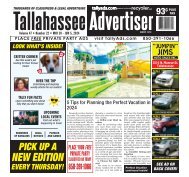TLA61_AllPages
Create successful ePaper yourself
Turn your PDF publications into a flip-book with our unique Google optimized e-Paper software.
Electric tractors likely have a future in our industry but are currently<br />
facing real-world issues, including significant range limitations, excessive<br />
vehicle weights, very high acquisition costs, higher-than-expected<br />
operating costs, excessively long lead times for charging equipment, and<br />
an underpowered electrical grid. Each of these issues will see improvement<br />
over the course of time, but policymakers have decided to force an<br />
accelerated timeline that doesn’t allow for the maturing of the technology.<br />
It’s become a matter of partisan politics, which is now producing<br />
unbalanced — even unreasonable — demands on our fleets.<br />
Hydrogen-powered solutions also hold promise but are likewise seeing<br />
significant early development challenges. I don’t want to be dramatic,<br />
but the current path is leading us towards a financial and operational<br />
wreck.<br />
We need policymakers to retool the rules to fit technologies that actually<br />
work today and allow future technologies to naturally mature. As for<br />
the myriad of recent California rules, that is a can of worms that we don’t<br />
have space to cover right now. Compliance with a rule should be achievable,<br />
it should apply to all equally, and it should be easy to understand. I<br />
believe they missed badly on this one.<br />
One of the stories in this edition of Truckload Authority<br />
touches on ways carriers can attract — and retain —<br />
safe, reliable drivers. While many offer sign-on bonuses<br />
or guaranteed weekly pay or home time to pull in new<br />
hires, how can carriers work to reduce driver turnover?<br />
After 31 years in this industry, I can safely say that I still have a lot<br />
to learn. Driver hiring and retention is one area that few have mastered,<br />
and a place where we all still have a lot to learn. I have seen a significant<br />
number of strategies to attract and retain drivers deployed in one way<br />
or another. Some strategies come across as very gimmicky, while others<br />
are more innovative.<br />
In the end, this is a “people business,” and each fleet needs to find<br />
a way to provide meaningful personal connections with their drivers …<br />
easier said than done. This involves creating a culture that goes beyond<br />
words. Surprisingly to some, I believe that it involves setting high expectations<br />
and holding people accountable to those expectations. It involves<br />
providing well-maintained equipment, favorable working conditions,<br />
consistent work opportunities, good benefits, and competitive pay. It involves<br />
building relationships and having healthy lines of communication<br />
to work through issues. It’s a balance of all of these efforts.<br />
No fleet does all of these things perfectly, but if, as an industry, we<br />
can focus on making progress related to each of these efforts, then we<br />
have a shot at making the driving job more attractive than other options<br />
that high-quality workers may have. I wish there was a silver bullet, but<br />
it is a lot of hard work.<br />
The American Transportation Research Institute<br />
(ATRI) has selected five topics on which to focus in<br />
2023, including expanding truck parking at public rest<br />
areas, identifying barriers to entry for female truck<br />
drivers, complete streets impact on freight mobility, the<br />
diesel technician shortage, and the cost of driver detention.<br />
Of these five, which two do you see as the most<br />
critical to the trucking industry, and why?<br />
I wish it was as simple as picking two priorities and saying that these<br />
priorities will bring the greatest amount of benefit to the industry. Just<br />
like a truck’s engine, every component performs a critical function. If any<br />
component fails, then the entire engine can be compromised. As an industry<br />
and as an association, we have to be prepared to make meaningful<br />
progress across several fronts. If I were to pick critical areas, my list<br />
On the topic of retaining quality drivers, Williams reminds carrier leadership that trucking is a<br />
“people business,” noting that it’s important to have meaningful discussions with employees.<br />
would certainly complement the areas you have mentioned — but might<br />
look a little different. In fact, these may sound familiar! I would pick:<br />
1. Improve the driving job and make it a more attractive job for all<br />
high-quality workers.<br />
2. Improve roadway safety through technology and by adopting effective<br />
best practices focused on reducing accidents.<br />
3. Improve motor carrier financial sustainability by educating carriers<br />
on proper returns on investment and by advocating for favorable tax<br />
policies and regulations.<br />
4. Shape the industry’s environmental stewardship by educating policymakers<br />
on the huge progress we have already made and then implementing<br />
reasonable real-world solutions going forward.<br />
5. Improve the industry’s image by highlighting the many things that<br />
the truckload industry does to support communities and keep America’s<br />
supply chain strong.<br />
I know this is a bit of a repeat from what I said earlier, but these are<br />
the things I would see as most critical. Within each of these five broader<br />
areas, there are a number of more specific challenges captured in the<br />
ATRI report that need to be addressed — including truck parking, barriers<br />
for female drivers, diesel technician shortages, and driver detention,<br />
just to name a few.<br />
Finally, what thoughts would you like to share with<br />
TCA members about the issues facing the trucking<br />
industry?<br />
The truckload industry is full of great people — smart people, who<br />
want to make a difference. We need more of this industry’s leaders to<br />
engage on these issues to help shape what this industry looks like for<br />
the next generation. There is no questioning the essentiality and critical<br />
nature of what we do for the economy. We just need to find more effective<br />
ways to move the needle.<br />
Thank you for your time, Mr. Chairman — and have a<br />
wonderful summer.<br />
TCA JULY/AUGUST 2023 www.Truckload.org | Truckload Authority 31

















